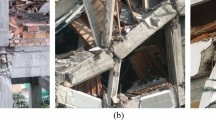Abstract
This study evaluates the structural performance of reinforced concrete interior beam–column joints having high-strength screw-type steel bars mechanically connected with couplers. A total of six full-scale specimens were cast and subjected to repeated cyclic lateral loads. High-strength screw-type reinforcing bars, with a yield strength of 690 MPa, were used as longitudinal reinforcement of the specimens. The main test variables were designed with and without couplers and the longitudinal reinforcement ratio of the beam. The couplers were applied to the plastic hinge zones of columns and beams to maximize their impact. The experiment confirmed that the flexural cracks generated near the couplers slightly influenced the initial stiffness, the yielding point of the longitudinal reinforcement of the beams, and the displacement at peak load of the specimens. However, the load versus story drift relationship, the peak load, and the ductility capacity of the specimens were not significantly affected. In addition, the analytical results obtained using the current structural design codes and finite element analysis were similar to the experimental results.













Similar content being viewed by others
References
Hanson NW, Connor HW. Seismic resistance of reinforced concrete beam-column joints. Proc Am Soc Civil Eng. 1967;93(ST3):533–60.
ACI-ASCE Committee 352. Recommendations for design of beam-column joints in monolithic reinforced concrete structures (ACI 352R-85). Farmington Hills, Mich: American Concrete Institute; 1985. 19pp.
Standards Association of New Zealand. New Zealand standard code of practice for the design of concrete structures. NZS 3101. Wellington: Standards Association of New Zealand; 1982.
Architectural Institute of Japan. AIJ Standard for Structural Calculation of Steel Reinforced Structures. Architectural Institute of Japan; 1975.
ACI-ASCE Committee 352, Recommendations for design of beam-column connections in monolithic reinforced concrete structures (ACI 352R-02). Farmington Hills, Michigan: American Concrete Institute; 2003. p. 1–16.
ACI Committee 318. Building code requirements for structural concrete (ACI 318–19) and commentary on building code requirements for structural concrete (ACI 318R-19). American Concrete Institute; 2019. 623pp.
Brooke NJ, Megget LM, Ingham JM. Bond performance of interior beam-column joints with high-strength reinforcement. ACI Struct J. 2006;103(4):596–603.
Feng J, Wang S, Meloni M, Zhang Q, Yang J, Cai J. Seismic behavior of RC beam column joints with 600 MPa high strength steel bars. Appl Sci. 2020;10(13):4684.
Hwang H-J, Park H-G, Choi W-S, Chung L, Kim J-K. Cyclic loading test for beam-column connections with 600 MPa (87 ksi) beam flexural reinforcing bars. ACI Struct J. 2014;111(4):913–24.
Lee H-J, Chang C-J. High strength reinforcement in exterior beam-column joints under cyclic loading. ACI Struct J. 2017;114(5):1325–38.
Chun S-C, Choi C-S, Jung H-S. Side-face blowout failure of large-diameter high- strength headed bars in beam-column joints. ACI Struct J. 2017;114(1):161–71.
Alaee P, Li B. High-strength concrete exterior beam-column joints with high-yield strength steel reinforcements. Eng Struct. 2017;145:305–21.
Alavi-Dehkordi S, Mostofinejad D, Alaee P. Effects of high-strength reinforcing bars and concrete on seismic behavior of RC beam-column joints. Eng Struct. 2019;183:702–19.
Lee J-Y, Kim J-Y, Oh G-J. Strength deterioration of reinforced concrete beam–column joints subjected to cyclic loading. Eng Struct. 2009;31(9):2070–85.
Paulay T, Priestley MJN. Seismic design of reinforced concrete and masonry buildings. Wiley; 1992.
Vecchio FJ, Collins MP. The modified compression field theory for reinforced concrete elements subjected to shear. Proc ACI J. 1986;83(2):219–31.
Vecchio FJ. Disturbed stress field model for reinforced concrete: Formulation. J Struct Eng. 2000;126(9):1070–7.
Vecchio FJ. http://vectoranalysisgroup.com /. Web Address of program VecTor2.
Wong PS, Vecchio FJ, Trommels H. VecTor2 and FormWorks user’s manual, 2nd ed. Technical Report, Department of Civil Engineering, University of Toronto, Toronto, Canada, 2013: 318pp. (http://vectoranalysisgroup.com/).
Collins MP, Porasz A. Shear design for high-strength concrete. Comité Euro-International du Béton, Bulletin d' Information No. 193, 1989: 75–83
Author information
Authors and Affiliations
Corresponding author
Ethics declarations
Conflict of interest
The authors declare that they have no conflict of interest.
Ethical statement
This research was done according to ethical standards.
Additional information
Publisher’s note
Springer Nature remains neutral with regard to jurisdictional claims in published maps and institutional affiliations.
Rights and permissions
About this article
Cite this article
Kim, SW., Chang, HJ. Structural performance of reinforced concrete interior beam–column joints with high-strength bars. Archiv.Civ.Mech.Eng 21, 97 (2021). https://doi.org/10.1007/s43452-021-00252-0
Received:
Revised:
Accepted:
Published:
DOI: https://doi.org/10.1007/s43452-021-00252-0




